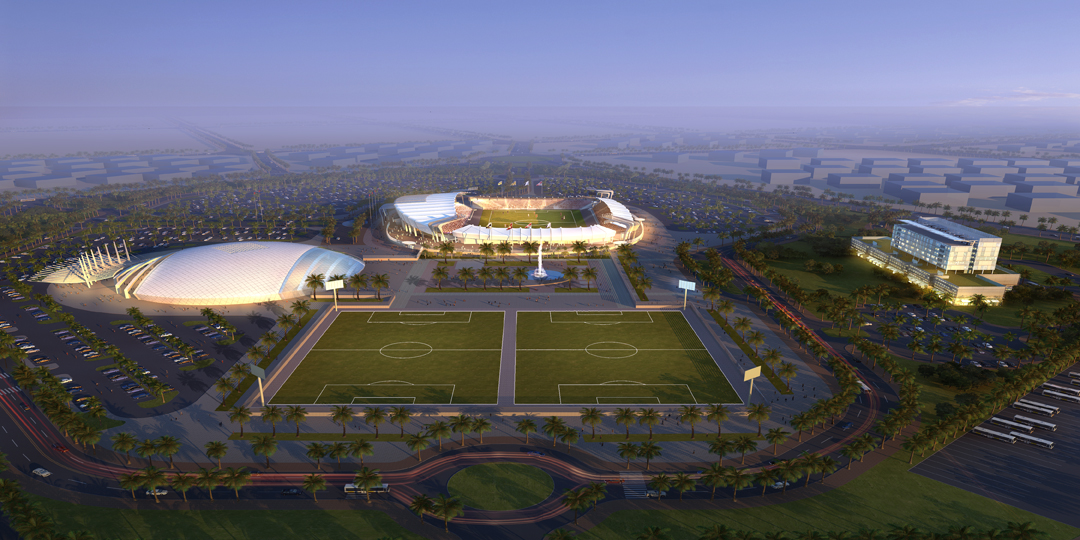The New York office of Perkins Eastman and design-build contractor Al Khayyat Contracting & Trading EST joined with the Private Engineering Office of the Emir to celebrate the start of construction for the 210,210 sf Lekhwiya Sports Complex—a mixed-use sports venue that will be the home stadium for Qatar's premier football team, Lekhwiya Club.
The complex also will be used as a training site and home base for a guest team participating in the 2022 World Cup.
Designed in collaboration with ECG, Pieper Sports Facility Consulting, and Site Concepts International, the Lekhwiya Sports Complex will serve as an identifiable icon for the home club, while its mix of uses will provide for a variety of experiences for players, fans, and sponsors alike.
The complex was designed to meet the business and operational goals of a world-class sports and entertainment complex and contributes to the architectural vitality of Qatar's largest city and its growing reputation as the region's sports capital.
As part of a larger athletic development underway for the 2022 World Cup taking place in Doha, Qatar, the first phase of the Lekhwiya Sports Complex will include a 60,000-sf, 10,000-spectator football stadium, practice facilities, and training fields to be complete by August 2012. The second phase will include a 129,210-sf) 75-room hotel, mosque, multi-sport arena, and related amenities. BD+C
Related Stories
Legislation | Aug 5, 2022
D.C. City Council moves to require net-zero construction by 2026
The Washington, D.C. City Council unanimously passed legislation that would require all new buildings and substantial renovations in D.C. to be net-zero construction by 2026.
Cultural Facilities | Aug 5, 2022
A time and a place: Telling American stories through architecture
As the United States enters the year 2026, it will commence celebrating a cycle of Sestercentennials, or 250th anniversaries, of historic and cultural events across the land.
Sponsored | | Aug 4, 2022
Brighter vistas: Next-gen tools drive sustainability toward net zero line
New technologies, innovations, and tools are opening doors for building teams interested in better and more socially responsible design.
| Aug 4, 2022
Newer materials for green, resilient building complicate insurance underwriting
Insurers can’t look to years of testing on emerging technology to assess risk.
Sustainability | Aug 4, 2022
To reduce disease and fight climate change, design buildings that breathe
Healthy air quality in buildings improves cognitive function and combats the spread of disease, but its implications for carbon reduction are perhaps the most important benefit.
Multifamily Housing | Aug 4, 2022
Faculty housing: A powerful recruitment tool for universities
Recruitment is a growing issue for employers located in areas with a diminishing inventory of affordable housing.
Multifamily Housing | Aug 3, 2022
7 tips for designing fitness studios in multifamily housing developments
Cortland’s Karl Smith, aka “Dr Fitness,” offers advice on how to design and operate new and renovated gyms in apartment communities.
Building Materials | Aug 3, 2022
Shawmut CEO Les Hiscoe on coping with a shaky supply chain in construction
BD+C's John Caulfield interviews Les Hiscoe, CEO of Shawmut Design and Construction, about how his firm keeps projects on schedule and budget in the face of shortages, delays, and price volatility.
Codes and Standards | Aug 3, 2022
Some climate models underestimate risk of future floods
Commonly used climate models may be significantly underestimating the risk of floods this century, according to a new study by Yale researchers.
| Aug 3, 2022
Designing learning environments to support the future of equitable health care
While the shortage of rural health care practitioners was a concern before the COVID-19 pandemic, the public health crisis has highlighted the importance of health equity in the United States and the desperate need for practitioners help meet the needs of patients in vulnerable rural communities.

















